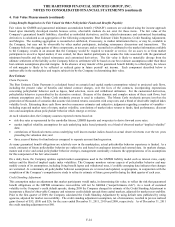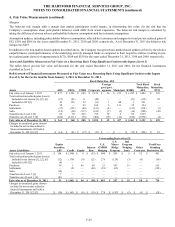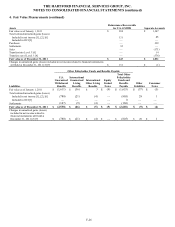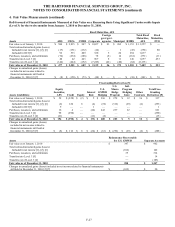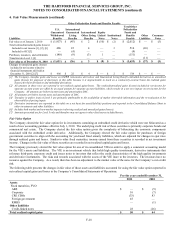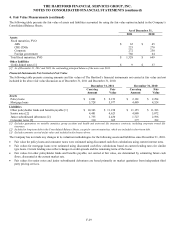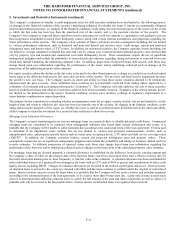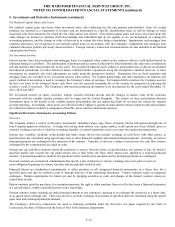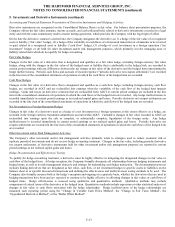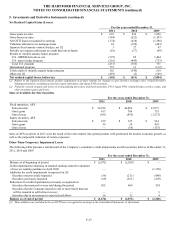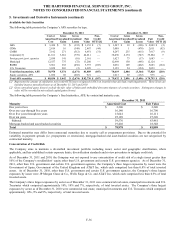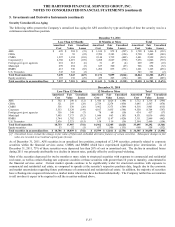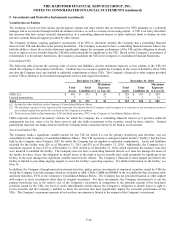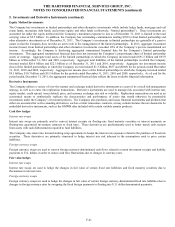The Hartford 2011 Annual Report Download - page 168
Download and view the complete annual report
Please find page 168 of the 2011 The Hartford annual report below. You can navigate through the pages in the report by either clicking on the pages listed below, or by using the keyword search tool below to find specific information within the annual report.
THE HARTFORD FINANCIAL SERVICES GROUP, INC.
NOTES TO CONSOLIDATED FINANCIAL STATEMENTS (continued)
F-33
5. Investments and Derivative Instruments (continued)
Accounting and Financial Statement Presentation of Derivative Instruments and Hedging Activities
Derivative instruments are recognized on the Consolidated Balance Sheets at fair value. For balance sheet presentation purposes, the
Company offsets the fair value amounts, income accruals, and cash collateral held, related to derivative instruments executed in a legal
entity and with the same counterparty under a master netting agreement, which provides the Company with the legal right of offset.
On the date the derivative contract is entered into, the Company designates the derivative as (1) a hedge of the fair value of a recognized
asset or liability (“fair value” hedge), (2) a hedge of the variability in cash flows of a forecasted transaction or of amounts to be received
or paid related to a recognized asset or liability (“cash flow” hedge), (3) a hedge of a net investment in a foreign operation (“net
investment” hedge) or (4) held for other investment and/or risk management purposes, which primarily involve managing asset or
liability related risks which do not qualify for hedge accounting.
Fair Value Hedges
Changes in the fair value of a derivative that is designated and qualifies as a fair value hedge, including foreign-currency fair value
hedges, along with the changes in the fair value of the hedged asset or liability that is attributable to the hedged risk, are recorded in
current period earnings with any differences between the net change in fair value of the derivative and the hedged item representing the
hedge ineffectiveness. Periodic cash flows and accruals of income/expense (“periodic derivative net coupon settlements”) are recorded
in the line item of the consolidated statements of operations in which the cash flows of the hedged item are recorded.
Cash Flow Hedges
Changes in the fair value of a derivative that is designated and qualifies as a cash flow hedge, including foreign-currency cash flow
hedges, are recorded in AOCI and are reclassified into earnings when the variability of the cash flow of the hedged item impacts
earnings. Gains and losses on derivative contracts that are reclassified from AOCI to current period earnings are included in the line
item in the consolidated statements of operations in which the cash flows of the hedged item are recorded. Any hedge ineffectiveness is
recorded immediately in current period earnings as net realized capital gains and losses. Periodic derivative net coupon settlements are
recorded in the line item of the consolidated statements of operations in which the cash flows of the hedged item are recorded.
Net Investment in a Foreign Operation Hedges
Changes in fair value of a derivative used as a hedge of a net investment in a foreign operation, to the extent effective as a hedge, are
recorded in the foreign currency translation adjustments account within AOCI. Cumulative changes in fair value recorded in AOCI are
reclassified into earnings upon the sale or complete, or substantially complete, liquidation of the foreign entity. Any hedge
ineffectiveness is recorded immediately in current period earnings as net realized capital gains and losses. Periodic derivative net
coupon settlements are recorded in the line item of the consolidated statements of operations in which the cash flows of the hedged item
are recorded.
Other Investment and/or Risk Management Activities
The Company’ s other investment and/or risk management activities primarily relate to strategies used to reduce economic risk or
replicate permitted investments and do not receive hedge accounting treatment. Changes in the fair value, including periodic derivative
net coupon settlements, of derivative instruments held for other investment and/or risk management purposes are reported in current
period earnings as net realized capital gains and losses.
Hedge Documentation and Effectiveness Testing
To qualify for hedge accounting treatment, a derivative must be highly effective in mitigating the designated changes in fair value or
cash flow of the hedged item. At hedge inception, the Company formally documents all relationships between hedging instruments and
hedged items, as well as its risk-management objective and strategy for undertaking each hedge transaction. The documentation process
includes linking derivatives that are designated as fair value, cash flow, or net investment hedges to specific assets or liabilities on the
balance sheet or to specific forecasted transactions and defining the effectiveness and ineffectiveness testing methods to be used. The
Company also formally assesses both at the hedge’ s inception and ongoing on a quarterly basis, whether the derivatives that are used in
hedging transactions have been and are expected to continue to be highly effective in offsetting changes in fair values or cash flows of
hedged items. Hedge effectiveness is assessed using qualitative and quantitative methods. Qualitative methods may include
comparison of critical terms of the derivative to the hedged item. Quantitative methods include regression or other statistical analysis of
changes in fair value or cash flows associated with the hedge relationship. Hedge ineffectiveness of the hedge relationships are
measured each reporting period using the “Change in Variable Cash Flows Method”, the “Change in Fair Value Method”, the
“Hypothetical Derivative Method”, or the “Dollar Offset Method”.



